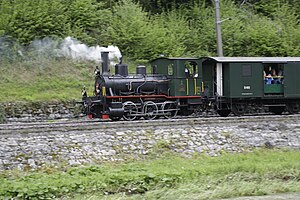SiTB E 3/3 No. 1 and 2
| E 3/3 | |
|---|---|
|
SiTB E 3/3 No. 2
|
|
| Numbering: | 1 and 2 |
| Number: | 2 |
| Manufacturer: | SLM |
| Year of construction (s): | 1892 |
| Retirement: | (1924 sale) No. 2 received |
| Axis formula : | C. |
| Gauge : | 1435 mm ( standard gauge ) |
| Length over buffers: | 7442 mm 7450 mm |
| Fixed wheelbase: | 2600 mm |
| Total wheelbase: | 2600 mm |
| Empty mass: | 20.4 t |
| Service mass: | 25.5 t 25.1 t |
| Friction mass: | 25.5 t |
| Wheel set mass : | 8.5 t |
| Top speed: | 35 km / h |
| Driving wheel diameter: | 1010 mm |
| Number of cylinders: | 2 |
| Cylinder diameter: | 340 mm |
| Piston stroke: | 500 mm |
| Boiler overpressure: | 10 atm. |
| Number of heating pipes: | 123 |
| Heating pipe length: | 2600 mm |
| Grate area: | 0.8 m² |
| Evaporation heating surface: | 49.8 m² |
| Water supply: | 3.1 m³ |
| Fuel supply: | 0.8 t 0.85 t coal |
| Speedometer: | Housekeeper |
| Control: | Walschaerts |
As E 3/3 Nos. 1 and 2, two Tender steam locomotive called, the 1892/93 by the Sihltalbahn were purchased.
The locomotive was obtained from the Swiss Locomotive and Machine Works (SLM) in Winterthur. The sales price is given as 45,000 Swiss francs.
They correspond in their design to the “small shunting type” of the Jura – Simplon railway; this type of the E 3/3 was first delivered to the Jura Bernois in 1875 .
history
The number 1 was purchased on the occasion of the opening of the Sihltalbahn. It was originally intended as a freight locomotive, but from the beginning it was also intended to help in passenger train service. The two E 2/2 were purchased for the passenger trains , but they quickly turned out to be too inefficient. A second machine was therefore immediately ordered in order to be able to run at least the heavy passenger trains with an E 3/3.
Technical
The second axle was the drive gear set, while the first and third axles were designed as coupled gear sets. A long Walschaerts control was installed as a control. It had long drive rods and a lever reversal. Here these two steam locomotives differ most obviously from the other four locomotives newly delivered to SiTB. Because these had a normal long Walschaerts control and short drive rods with reversing with handwheel.
The steam dome with safety valve and the sand dome were located on the boiler. The two sand pipes only led in front of the drive axis and therefore only worked well when driving forward.
The leaf springs were arranged above the rotating plate and supported by the spring collar on the axle bearing via a rod. A balance lever was attached between the first and second springs.
A Westinghouse brake was installed as an air brake. It worked both as an automatic brake for the entire train, and from 1912 as a regulating brake only on the locomotive. Four-block spindle brakes were installed, and the air brake also acted on the same brake blocks. The second and third axles were braked on one side. The air pump was attached to the side of the smoke chamber. It was replaced by a more powerful one in 1911. The air tank was attached under the driver's cab.
The locomotive whistle was on the cab roof.
In the years 1898/99 a smoke burner from the Langer system was installed. At that time, a tire sprayer was also installed. The type of wheel flange lubrication helped to reduce wear.
Operational
The locomotives were to be found before all types of trains. When the line was electrified in 1924, they became redundant and were both sold to the Basel gasworks.
Whereabouts
No. 1 was sold to the Basel gas works in 1924, where it kept its number. It was scrapped and scrapped in 1948. As a replacement, the former SiTB E 3/3 No. 6 came from the UeBB to Basel, which also received the number 1.
No. 2 was sold to the Basel gasworks in 1924, where it kept its number. In 1987 the locomotive was handed over and came to Lake Geneva, where it was used for the "Train Blue". This operated between Bouveret and Evian. This operation had to be stopped because the section of the route on French territory became impassable. The ZMB was able to bring the operational locomotive back to the Sihl valley in 2004, where it is now available for steam extra trains in addition to No. 5.
literature
- Hans Waldburger, Hans Tempelmann: The Sihltalbahn. 100 years from the steam train to the modern S-Bahn line. Minirex, Luzern 1992, ISBN 3-907014-06-5 , pages 73-78
Web links
- Website of the Zürcher Museum-Bahn (current owner of locomotive no.2)
